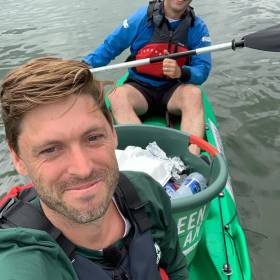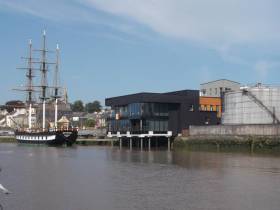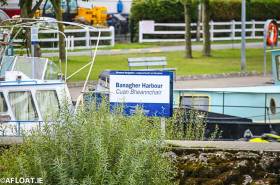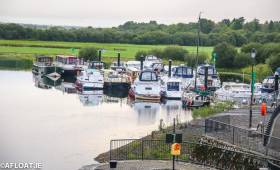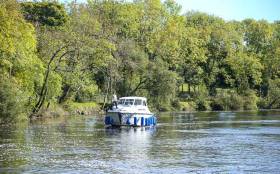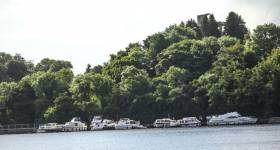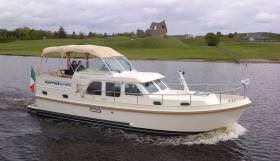Displaying items by tag: inland waterways
Kayakers Invite Volunteers to Clean Up Liffey
A new clean-up initiative which involves volunteers kayaking down the river Liffey to pick up rubbish has been launched.
GreenKayak, a Danish non-governmental organisation founded in 2017 by Tobias Weber-Andersen, reports The Irish Times, operates a free service where volunteers sign up to kayak along the river in exchange for picking up litter.
The initiative launched its first Irish venture, in partnership with Dublin’s City Kayaking, on Tuesday. It aims to collect plastic from the river Liffey before it reaches the Irish Sea.
Each kayak is fitted with a bin and tools for grabbing plastic bobbing on the water’s surface. Each bin is weighed after docking, and the waste is recycled.
Volunteers must then share their experience on social media to promote the initiative, see related link.
Click here to read more on the background of this initiative
Takeover of New Ross Port to Unlock River’s Potential
#irishports - New Ross Port is to be transferred to Wexford County Council within the coming months and will lead to great opportunities for the development of the quays area of the town.
As NewRoss Standard writes, this is the view of director of services for economic development with Wexford County Council, Tony Larkin who addressed the monthly meeting of New Ross Municipal District.
Mr Larkin said the 'bottom tier' ports in Ireland are being transferred to local authorities.
'It's New Ross' turn. We have been in negotiations with the Department of Transport for two years. We've been doing due diligence on the port company and I compliment the work of the port company.'
He said the company is being disbanded and will merge into the council.
Mr Larkin said the transfer could occur as soon as May or June, and would have already taken place if not for some cost issues involving the removal of the oil tanks on the quay and the cost of draining the Barrow.
For the transfer to take place three ministers have to sign the transfer letter.
For further reading on this development at the inland port click here.
The winter mooring period ends on Sunday 31 Mar 2019. Thereafter Navigation Bye-law No. 17(3) applies i.e. vessels should not berth in the same harbour for longer than the statutory period of 5 consecutive days nor more than a total of 7 days in any one month.
Winter Mooring Period Begins on Ireland's Inland Waterways
The winter mooring period has begun and with it a number of changes to the operation of Waterways Ireland’s moorings.
Winter mooring is available on Waterways Ireland moorings on the River Shannon for the 5 month period 1 November – 31 March for a fee of €63.50. For 2018-2019 bookings visit here
From the 7th November electricity and water to Waterways Ireland jetties, harbours and marinas will be turned off to reduce damage from winter weather including storms and freezing conditions. A Marina Notice will issue when both services are re-connected in 2019.
Over the winter Waterways Ireland advises boat owners to take additional precautions if visiting their vessels during any stormy weather and heavy rainfall. Slippery conditions and strong winds are a hazard when walking on floating pontoons and when moving boats. Certainly boat owners should consider wearing full personal protective equipment if it is deemed necessary to visit a vessel during stormy weather.
Boaters should also note the closure of Albert Lock and Athlone Lock for 6 weeks from the 5th and 12th November respectively for essential maintenance works and passage through the locks will not be possible during this time.
Waterways Ireland will continue to issue Marine Notices throughout the winter period to advise boaters of changes to navigation conditions. Marine Notices are published on the Waterways Ireland website.
Jet Boat Rules on Ireland's Rivers & Inland Waterways
Afloat.ie reader, Chris, is trying to find out what the rules and limitations are for jet boating on Irish rivers. In particular, he was curious to know if there are any regulations governing speed limits.
A jetboat is a boat propelled by a jet of water ejected from the back of the craft. Unlike a powerboat or motorboat that uses an external propeller in the water below or behind the boat, a jetboat draws the water from under the boat through an intake and into a pump-jet inside the boat, before expelling it through a nozzle at the stern.
Jetboats were originally designed by Sir William Hamilton (who developed a waterjet in 1954) for operation in the fast-flowing and shallow rivers of New Zealand, specifically to overcome the problem of propellers striking rocks in such waters.
We passed Chris's query to Waterways Ireland, the body responsibile for the management, maintenance, development and restoration of inland navigable waterways, principally for recreational purposes.
WI responded as follows:
'Waterways Ireland actively encourages the use of Ireland's waterways for all types of activities including jet-boating. In this context the rivers and lakes under the remit of Waterways Ireland are available for jet-boating with some public safety restrictions to be respected.
There is a 5 knot speed limit in place in the vicinity of all marinas and harbours. We encourage a no wake policy in the vicinity of moorings, jetties and swimming areas. We have received occasional complaints from other boat users regarding excessive speed by jet skis and powerboats in the vicinity of marinas etc, consideration for other water users is encouraged.
'Lough Derg between Portumna and Terryglass is an area that is used for water-ski training and would be ideal for jet-boating'
The Lower Bann river between Lough Neagh and Coleraine has zones used primarily for powered water sports and could be an ideal jet-boating location. Lough Derg between Portumna and Terryglass is an area that is used for water-ski training and would be ideal for jet-boating.
There are Waterway Ireland offices in various locations along the lakes and river network who can advise further on local matters when you are on the waterway'.
Heritage Bill to Determine the Future of Ireland's Canals
Could The Heritage Bill destroy the Navigations it should be protecting? That's the view of the Inland Waterways Association of Ireland (IWAI).
In a long running campaign, the IWAI has received strong political support for its view that this proposed legislation must put user requirements, tourism development and local communities at the centre of the regulations.
The Heritage Bill 2016 is currently before the Dáil. With several Amendments still to be considered by the Oireachtas, The Inland Waterways Association of Ireland (IWAI) is hopeful that the final shape of the Bill has the potential to unlock a bright future for the Grand Canal, Royal Canal and Barrow Navigation that will put user requirements, tourism development and local communities at the centre of the regulations.
Could The Heritage Bill destroy the Navigations it should be protecting?
The Bill is scheduled for debate by the Select Committee on Culture, Heritage and the Gaeltacht this Wednesday afternoon. Once again there is strong political support for the IWAI view but concerns remain with the proposed legislation, this is reflected by the number of Amendments on the table for discussion on Wednesday.
The main areas of concern relate to
• new complicated legal licensing, - rather than the need to legislate for a simple permitting system that is customer friendly, easy to use, and fit for purpose
• Adequate provisions - so that boats of dimensions for which the canals were built to accommodate are protected and can continue to do so into the future
• proposed provision and powers of Authorised Officers
• legislation that will facilitate the introduction of a complete different set of rules and regulations that are not in place on the adjoining Waterways, and will make these canals less attractive to potential boating tourism
Ireland’s Canals as beautiful linear waterways have the potential to attract both domestic and International boating visitors who will relish the tranquil opportunity of slow tourism cruising at walking pace as people move faster than the canal boats on the system, while experiencing the associated industrial heritage, peat lands, small villages and towns that have interdependence with the canals and our capital city.
To achieve this potential it is vital that the Heritage Bill 2016 preserves and enables the development of the canals for the current and future generations and communities. Over regulation and excessive charges are not the answer to developing these waterways; they deserve proper legislation that put user requirements, local communities and tourism at the centre of the regulations.
The Ulster Architectural Heritage Society will bring the Heritage Angel Awards to Northern Ireland for the first time and IWAI Newry and Portadown have been shortlisted to receive a Heritage Angel Award in the category Best Rescue, Recording or Interpretation of a Historic Place. On learning of the group's success Peter Maxwell the Branch treasurer said: "It's a huge honour for us to have won through the nomination process and we are looking forward to the decision. It's a great opportunity for us to spread the word about the canal and what a fantastic asset it is to the community."
IWAI Newry and Portadown volunteers have created a video entitled ‘New Life for the Old Canal’ that celebrates the project to re-water the summit level of the Newry Canal, a four mile stretch of water from Poyntzpass to Scarva. New lock gates were built and installed by the volunteers to allow canoes and small boats to use the canal. Alongside this the group researched and published a guided walk app highlighting the history of the canal. They also manage a heritage centre on the towpath with displays to help visitors understand how a canal works and how its restoration could help boost the local economy.
The purpose of the Heritage Angel Awards is to recognise groups that inspire and increase activity to help conserve and protect built heritage, a purpose that according to Peter, IWAI Newry and Portadown volunteers support very strongly; "We certainly meet that aim as our volunteers contribute more than 2000 hours annually to canal projects. Without our input it's fair to say that the canal, dating from 1742 and the first of its kind in Ireland & the UK would again become a neglected, overgrown ditch as was the case when it was abandoned in 1949. Instead, our project on the summit has shown how the canal can be used by many different types of people for recreation and enjoyment."
Peter’s enthusiasm and that of his fellow volunteers clearly shows the potential impact that a project like this can have on society as a whole. Please show your support and cast your vote now to show that there most definitely is new life for the old canal. Logon to https://www.heritageangelawards-ni.org.uk/ Voting closes on Friday October 27th. The awards ceremony will take place in the Grand Opera House, Belfast on Tuesday November 7th. The Awards are funded by the Andrew Lloyd Webber Foundation and the Department for Communities.
Waterways Ireland advises Masters and Owners of vessels berthed in public harbours, at jetties or moorings against visiting any vessels or boats during periods of extreme weather such as storm force winds and heavy rainfall.
Strong winds are a hazard to personal safety if walking on or near navigation infrastructure and also because of blown debris from trees or buildings in the vicinity. There is also the hazard of the unpredictable nature of rising water levels and their effect on built infrastructure.
Canal banks will be muddy and slippery. Access to vessels could be hazardous.
At present a number of mooring facilities and access ramps to same and the approach roads and paths to their associated car parks are underwater or are inaccessible across all navigations.
Fast flowing currents, eddies and turbulent water will be experienced in and around these structures for some time after the storms have passed.
Mooring lines and cleats on vessels at these facilities will be under strain as will the shore bollards that they are made fast to. Extreme care should be exercised when releasing lines in these circumstances to avoid them snapping back and causing injury. There is also the danger of deck cleats, which may have been weakened whilst under strain, pulling out and striking a person when engaged in this activity.
Waterways Ireland further advises that full personal protective equipment such as lifejacket and foul weather gear be worn if it is deemed necessary to visit a craft in a harbour that the visit is undertaken in company with a colleague and that someone has been advised of an expected return time. A fully charged mobile phone should be carried in the event of an emergency and the visit should be made during daylight hours.
Celebrating the Grand Re-Opening: 30 Years of the Naas Canal
The Inland Waterways Association of Ireland (IWAI) Kildare will return again to Naas Harbour to celebrate the Naas Canal Festival which runs from Friday October 27th to Monday October 30th. This year’s Festival is a very special event as 2017 marks 30 years since the Naas Line of the Grand Canal was re-opened to boat traffic. In the early 1980s, a fledgling IWAI Kildare, supported by IWAI Dublin, highlighted the potential for tourism development of the Grand Canal in Naas. 30 years on and a large fleet of boats is expected to attend the Festival in Naas Harbour. On Friday 27th and Saturday 28th the travelling boats will be assisted through the locks by staff from Waterways Ireland, IWAI Kildare volunteers and members of the 23rd Kildare – Sallins – scouts, who are eager to put their lock operation training into practice. If you have never seen a lock being used or you have never seen a boat cruise the canal, this October weekend will not disappoint.
As well as the flotilla of vessels old and new, there will be a number of public events in the lead up to and during the Festival. A Waterways Exhibition will run in Naas Library from Monday October 23rd to Friday 27th featuring material from IWAI, the Heritage Boat Association and Waterways Ireland. There will be a variety of activities taking place on Sunday afternoon, October 29th, from 1pm to 5pm, including music from The Water Gypsies, Waterways Information Talks, an Exhibition by Sean Curran Art, boat trips on the canal by bargetrip.ie, the launch of a new children’s book by author Emma-Jane Leeson who will host readings from her book on a Barge. Of course, the boats themselves will also be on display and the boat owners will be on hand waiting to answer your questions or even give you a tour; don’t be shy about approaching them.
In the spirit of the founders of the IWAI, who established the Association in 1954 to campaign against the installation of fixed-span bridges across the River Shannon, IWAI Kildare will use the Naas Canal Festival to continue to showcase the leisure potential and historical significance of the Grand Canal in this area.
The Inland Waterways Association of Ireland (IWAI) is a voluntary body representing over two thousand enthusiasts, with 23 branches across the island of Ireland.
The Inland Waterways Association of Ireland (IWAI) is an energetic, fun, voluntary organisation with members from all corners of the Island of Ireland, all sharing a keen and passionate enthusiasm for the waterways of Ireland.
The IWAI advocates the navigation, use, maintenance, protection, restoration and improvement of the inland waterways of Ireland. It was formed in 1954 to promote the development, use and maintenance of Ireland's navigable rivers and canals.
IWAI Kildare was established in 1984. In the early years IWAI Kildare was assisted by IWAI Dublin to restore and enable the re-opening to navigation of the Naas Line of the Grand Canal main line. Currently, IWAI Kildare aims to promote the use of the waterways of Co. Kildare by running rallies throughout the county.
IWAI Kildare is actively campaigning to re-open the Corbally Line of the Grand Canal from Naas Harbour to Corbally Harbour. This stretch of waterway is in good condition but passage for boats is blocked by a number of culverted crossings, including the road from Naas to Newhall which crosses the canal near Jigginstown.
With its first hire this Saturday, River Shannon Boat hire firm Carrickcraft is launching the first of its new steel–built Linssen vessels just in time for the 2017 season.
As Afloat.ie reported earlier, Ireland's largest cruise hire charter company is expanding its 115–boat fleet with the addition of five Dutch built boats over the next few seasons.
The first of these new steel yachts was on trial this week as pictured above at Clonmacnoise in Co. Offfaly.
Cruise-Ireland placed an order at Linssen Yachts for five new yachts, which involves a turnover of more than €1m. The aim of this long-term collaboration is to extend the Cruise-Ireland fleet with several new Linssen Yachts every one or two years. Cruise-Ireland is a combination of two of the oldest yacht charter companies in Ireland: Carrickcraft and Waveline Cruisers.
New boats will go into the Cruise-Ireland bases in Banagher, two in Carrick and one on the Shannon one-way route.


























